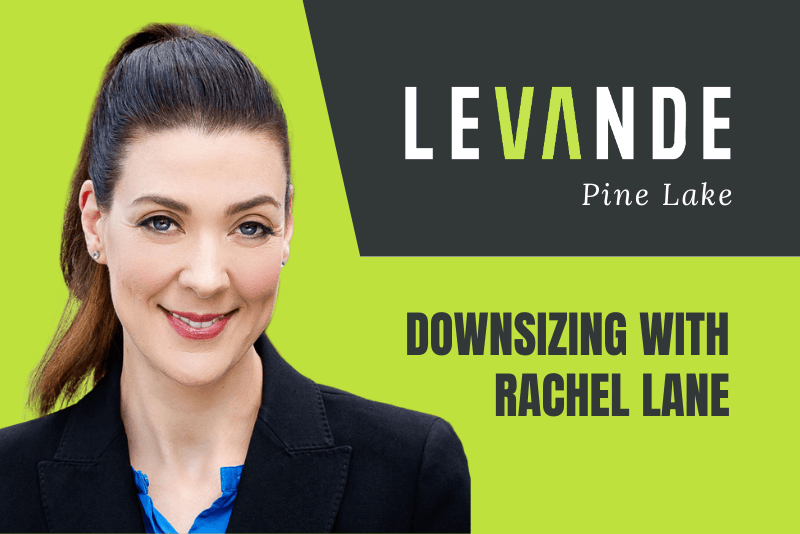
“We turn not older with years but newer every day.” EMILY DICKINSON
Welcome to our April newsletter
The budget has now been handled down and we are now in election mode.
This is shaping up to be one of the most important elections in recent memory — yet the major coalitions have virtually no chance of governing on their own. The most likely outcome is a hung parliament, with power shared between the party that secures the most votes and a range of minor players.  When Bob Hawke was elected in 1983, the two major parties — Labor and the Coalition — commanded 90% of the primary vote. By the last election, that figure had dropped to 68%. Now, it’s roughly 30% for Labor, 30% for the Coalition, and the remaining 40% split among an assortment of minor parties, including the Greens, the Teals, One Nation, and various independents. To govern in its own right, Labor must secure 76 seats. But if it loses just three electorates, it will fall short of that number and be forced to negotiate with crossbenchers to form government. The challenge is even greater for Peter Dutton. To win government outright, the Coalition must pick up 22 seats — while holding onto every seat it already controls. It’s a Herculean task, one that would require a massive electoral swing. For voters, this means the power to shape the next government may lie not just with choosing between Labor or the Coalition, but also with deciding which minor parties or independents will hold the balance of power. In such a fragmented landscape, preferences matter more than ever — and so does understanding where every candidate stands. It’s no longer just about who leads; it’s about who they’ll need to work with.
When Bob Hawke was elected in 1983, the two major parties — Labor and the Coalition — commanded 90% of the primary vote. By the last election, that figure had dropped to 68%. Now, it’s roughly 30% for Labor, 30% for the Coalition, and the remaining 40% split among an assortment of minor parties, including the Greens, the Teals, One Nation, and various independents. To govern in its own right, Labor must secure 76 seats. But if it loses just three electorates, it will fall short of that number and be forced to negotiate with crossbenchers to form government. The challenge is even greater for Peter Dutton. To win government outright, the Coalition must pick up 22 seats — while holding onto every seat it already controls. It’s a Herculean task, one that would require a massive electoral swing. For voters, this means the power to shape the next government may lie not just with choosing between Labor or the Coalition, but also with deciding which minor parties or independents will hold the balance of power. In such a fragmented landscape, preferences matter more than ever — and so does understanding where every candidate stands. It’s no longer just about who leads; it’s about who they’ll need to work with.
Watch for the rubbish
 Between now and polling day we’ll be bombarded with the usual avalanche of sensational headlines, all designed to steer us one way or the other. They might grab attention, but scratch the surface and they often start to fall apart. Take this week’s example: “True cost of super raids for deposits.” The headline screams crisis. The claim? That letting first homebuyers access their super could cost taxpayers more than $1.4 billion a year by 2050 in extra age pension costs. It sounds dramatic, but dig deeper. The figure came from the Parliamentary Budget Office, theoretically independent, but hinges on a hypothetical 40-year-old pulling out $50,000 next year, then retiring at 67 with no further effort to rebuild their balance. That’s a pretty shaky foundation. The calculation of the figure gives no credit for the upside of getting into a home sooner, or the long-term wealth that can come from owning property earlier. And there’s not a word about the downsizer contribution – $300,000 into super after age 55 – which could more than make up the difference. Labor MP and Chair of the Parliamentary Standing Committee on Economics, Daniel Mulino, weighed in, warning that “Peter Dutton’s reckless plan to raid super will push house prices up.” For starters, it’s not a raid – it’s an idea to enable first home buyers to use part of their super for a house deposit, on the condition it would be paid back, plus earnings. Yes, it may push house prices up, but so does every other strategy that helps home buyers into the market. These include stamp duty concessions, Labor’s proposal to help homebuyers by using shared ownership, and even the recent reduction to interest rates. Let’s take a closer look at what the Coalition is actually proposing under their Super Home Buyer Scheme. First homebuyers would be able to access up to $50,000 or 40% of their super – whichever is less – to help purchase a home. But here’s the crucial detail: the money must be repaid when the property is sold, along with a proportionate share of any capital gain. In effect, the withdrawn amount is returned to super, along with its share of the home’s appreciation – similar to how an investment would have grown if it had stayed in the fund. For example, if a buyer withdrew $40,000 from their super and sold the house seven years later with a 10% increase in value, they would be required to repay $44,000 – the original $40,000 plus $4,000 representing their share of the capital gain. So it’s not a raid: it’s an investment, with a built-in mechanism to preserve long-term retirement savings. Take a couple both 35, with $84,000 in super each and $85,000 saved. Without the scheme, they’d face $21,000 in mortgage insurance. But by withdrawing $36,000 each from super, they could reduce that cost to just $6,700 – saving over $14,000. This could help them reach a lower loan-to-valuation ratio sooner, when they could refinance at better rates. The scheme gives them a leg up today, without permanently sacrificing their retirement savings.
Between now and polling day we’ll be bombarded with the usual avalanche of sensational headlines, all designed to steer us one way or the other. They might grab attention, but scratch the surface and they often start to fall apart. Take this week’s example: “True cost of super raids for deposits.” The headline screams crisis. The claim? That letting first homebuyers access their super could cost taxpayers more than $1.4 billion a year by 2050 in extra age pension costs. It sounds dramatic, but dig deeper. The figure came from the Parliamentary Budget Office, theoretically independent, but hinges on a hypothetical 40-year-old pulling out $50,000 next year, then retiring at 67 with no further effort to rebuild their balance. That’s a pretty shaky foundation. The calculation of the figure gives no credit for the upside of getting into a home sooner, or the long-term wealth that can come from owning property earlier. And there’s not a word about the downsizer contribution – $300,000 into super after age 55 – which could more than make up the difference. Labor MP and Chair of the Parliamentary Standing Committee on Economics, Daniel Mulino, weighed in, warning that “Peter Dutton’s reckless plan to raid super will push house prices up.” For starters, it’s not a raid – it’s an idea to enable first home buyers to use part of their super for a house deposit, on the condition it would be paid back, plus earnings. Yes, it may push house prices up, but so does every other strategy that helps home buyers into the market. These include stamp duty concessions, Labor’s proposal to help homebuyers by using shared ownership, and even the recent reduction to interest rates. Let’s take a closer look at what the Coalition is actually proposing under their Super Home Buyer Scheme. First homebuyers would be able to access up to $50,000 or 40% of their super – whichever is less – to help purchase a home. But here’s the crucial detail: the money must be repaid when the property is sold, along with a proportionate share of any capital gain. In effect, the withdrawn amount is returned to super, along with its share of the home’s appreciation – similar to how an investment would have grown if it had stayed in the fund. For example, if a buyer withdrew $40,000 from their super and sold the house seven years later with a 10% increase in value, they would be required to repay $44,000 – the original $40,000 plus $4,000 representing their share of the capital gain. So it’s not a raid: it’s an investment, with a built-in mechanism to preserve long-term retirement savings. Take a couple both 35, with $84,000 in super each and $85,000 saved. Without the scheme, they’d face $21,000 in mortgage insurance. But by withdrawing $36,000 each from super, they could reduce that cost to just $6,700 – saving over $14,000. This could help them reach a lower loan-to-valuation ratio sooner, when they could refinance at better rates. The scheme gives them a leg up today, without permanently sacrificing their retirement savings.
Fix the mortgage insurance hurdle
 Image by storyset on Freepik
Image by storyset on Freepik
Instead of trading scary numbers, all parties would do far better to focus on a problem that’s hurting first-home buyers right now: mortgage insurance. It’s compulsory if you’ve got less than a 20% deposit. Fair enough. But the real sting? It’s non-transferable. If you’ve paid it once and want to refinance – even with the same property and the same loan amount – you have to pay it again. And it’s not pocket change: that second hit could easily top $20,000. Time and time again we’re told to shop around for a better rate. But for borrowers with smaller deposits, the cost of jumping ship to a new lender is a concrete wall. You’re locked in, even if a cheaper deal is waiting next door. There’s a simple fix: one that would cost the federal budget nothing. Legislate to make mortgage insurance portable. That alone would make first-home ownership more affordable, more flexible, and more competitive – without touching super or the pension system.
Who are you?
 Image by rawpixel.com on Freepik
Image by rawpixel.com on Freepik
On the very day the election was called, I received a flurry of text messages from women who introduced themselves by name and praised the achievements of the Labor government. But when I replied and asked where they were from, it turned out they were Labor candidates. My response was If you’re so embarrassed by the party you represent that you won’t even mention its name to voters, why send a text at all? Then came the budget. The next morning, a headline $450 million bonus for pensioners. It gave me a jolt—was there something new I hadn’t seen? But on closer inspection, it was rubbish. There was no bonus. All the government had done was leave the deeming rates unchanged. Seriously, would any government dare to increase deeming rates and strip hundreds of thousands of pensioners of part of their income five weeks before an election?
The Podcast
Renowned broadcaster John Deeks and I discuss all the big topics covered in this newsletter in detail each month.
Budget Reflections
 Last Tuesday was budget night — a budget the government hadn’t expected to deliver — and by now, most of its contents have been widely publicised. From a financial planning perspective, one of the more significant changes is the reduction in the marginal tax rate on incomes between $18,200 and $45,000 from 16% to 15%. This aligns with the 15% tax already deducted from concessional contributions to super. As a result, for low-income earners, making deductible contributions to super may no longer make sense — there’s no longer a tax advantage. In many cases, they may be better off making an after-tax (non-concessional) contribution and then claiming the government’s superannuation co-contribution instead.
Last Tuesday was budget night — a budget the government hadn’t expected to deliver — and by now, most of its contents have been widely publicised. From a financial planning perspective, one of the more significant changes is the reduction in the marginal tax rate on incomes between $18,200 and $45,000 from 16% to 15%. This aligns with the 15% tax already deducted from concessional contributions to super. As a result, for low-income earners, making deductible contributions to super may no longer make sense — there’s no longer a tax advantage. In many cases, they may be better off making an after-tax (non-concessional) contribution and then claiming the government’s superannuation co-contribution instead.
Spreading the word!
I thoroughly enjoyed last week’s events. Her’s a shot from Currumbin Friday 28 March:  It was so gratifying to mix with so many subscribers to this newsletter and hear their stories. The newsletter has now been running for over 25 years, and it’s just wonderful to meet readers who’ve been with me for that entire journey. We discussed a wide range of topics—including capital gains tax, superannuation, downsizing, and aged care—and one thing became crystal you need expert advice. It can cost you dearly if you don’t get it. Rachel shared a great example involving a couple moving into a retirement village. They had to choose between paying a lower entry fee with a higher exit fee, or the reverse: a higher entry fee with a lower exit fee. After obtaining an Age Guru Report, the couple chose to increase their initial entry fee by $200,000. That decision meant they converted assessable assets into exempt ones, which increased their age pension by $15,600 a year. Over 10 years, that meant a $156,000 boost to their pension—and they also saved $150,000 on the exit fee. In total, they were $306,000 better off. Our final seminars will be held this week in Sydney at two wonderful venues. Details are below. I’d love to see you there and have a chat – it’s always a pleasure to connect in person.
It was so gratifying to mix with so many subscribers to this newsletter and hear their stories. The newsletter has now been running for over 25 years, and it’s just wonderful to meet readers who’ve been with me for that entire journey. We discussed a wide range of topics—including capital gains tax, superannuation, downsizing, and aged care—and one thing became crystal you need expert advice. It can cost you dearly if you don’t get it. Rachel shared a great example involving a couple moving into a retirement village. They had to choose between paying a lower entry fee with a higher exit fee, or the reverse: a higher entry fee with a lower exit fee. After obtaining an Age Guru Report, the couple chose to increase their initial entry fee by $200,000. That decision meant they converted assessable assets into exempt ones, which increased their age pension by $15,600 a year. Over 10 years, that meant a $156,000 boost to their pension—and they also saved $150,000 on the exit fee. In total, they were $306,000 better off. Our final seminars will be held this week in Sydney at two wonderful venues. Details are below. I’d love to see you there and have a chat – it’s always a pleasure to connect in person.
Upcoming Events
This Week in Sydney
There are only 2 opportunities left to join us for one of our Sydney high tea events this week.
Rachel Lane and I will share the dos, the don’ts, and the most important factors you should consider before downsizing.
Brought to you by RSL LifeCare – committed to creating a new benchmark of community for veterans and seniors in the Northern Beaches.
Register below:

2 April Wednesday
From 10am, for a 10:30am start till 1pm
Killara Golf Club The Dining Room
556 Pacific Highway

3 April Thursday
From 10am, for a 10:30am start till 1pm
Manly Golf Club The Apperly Room
38-40 Balgowlah Rd, Balgowlah
Gold Coast
On Wednesday 16 April Rachel Lane (my co-author on Downsizing Made Simple) will be giving a presentation on the Gold Coast. She will be talking about:
- The legal and financial implications of moving into a retirement village
- How to crunch the numbers on different payment options villages offer
- The rules for making a downsizer contribution to your superannuation
- How downsizing can affect your pension and other entitlements
- And what happens if you need aged care in the future.
If you are thinking about downsizing this is a seminar you don’t want to miss! Details: Date: Wednesday 16 April Time: 10.15am – 1.00pm (a light lunch will be served) Where: Pine Lake Village Community Centre – 11 Aracuria Way, Elanora Numbers are limited and RSVP’s are essential, to book your place: RSVP Here
Super strategies
June 30 is getting close, and as I reminded my audiences last week, there are important steps to take if you think you’ll be making a taxable capital gain in the next year or so.
 Image by rawpixel.com on Freepik
Image by rawpixel.com on Freepik
Capital gains tax is calculated by adding the discounted gain to your taxable income in the year the sales contract is signed. One strategy is to delay signing the contract until you’re in a lower tax bracket – but the most common (and often most effective) strategy is to make a tax-deductible superannuation contribution. That contribution must be made in the same financial year the contract is signed. A reader recently emailed me asking what kind of deductible contribution they could make. But when they mentioned the contract had been signed in March last year, I had to give them the bad news: they’d missed the opportunity, because any contribution had to be made by June 30 of that year. The good news? If you’re a senior, you can still contribute to super up to age 75—provided you meet the work test, which simply involves working 40 hours in any 30 consecutive days during the year you make the contribution. That shouldn’t be hard for any resourceful retiree. And here’s the real opportunity: if your total super balance at last June 30 was under $500,000, you may be able to carry forward unused concessional contributions and put in up to $160,000 this year. That could wipe out your capital gains tax entirely. Of course, you must take advice—but simply knowing this strategy exists might be the incentive you need to act now. I go into full detail on these and many other strategies in my books Retirement Made Simple, Wills, Death & Taxes Made Simple, and Super Made Simple. They’re available from my bookshop and could make a big difference to your financial future. 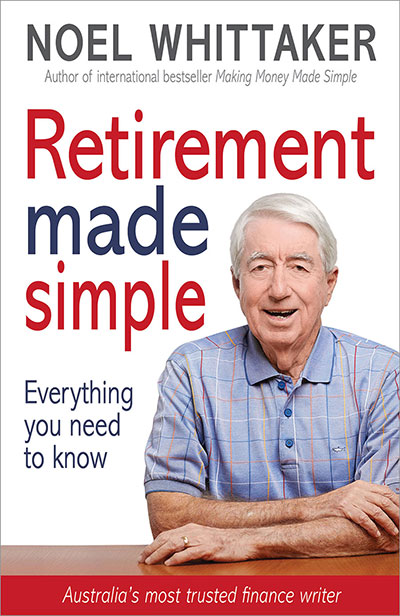
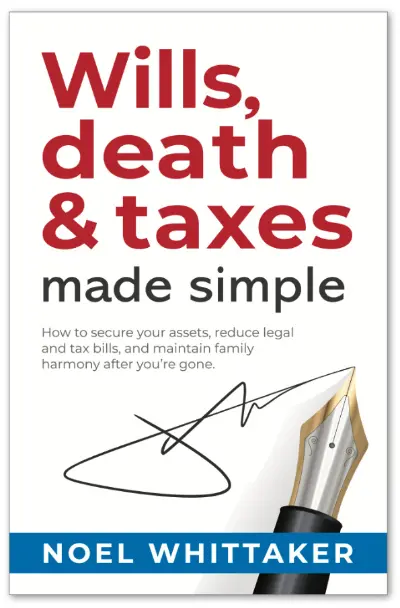
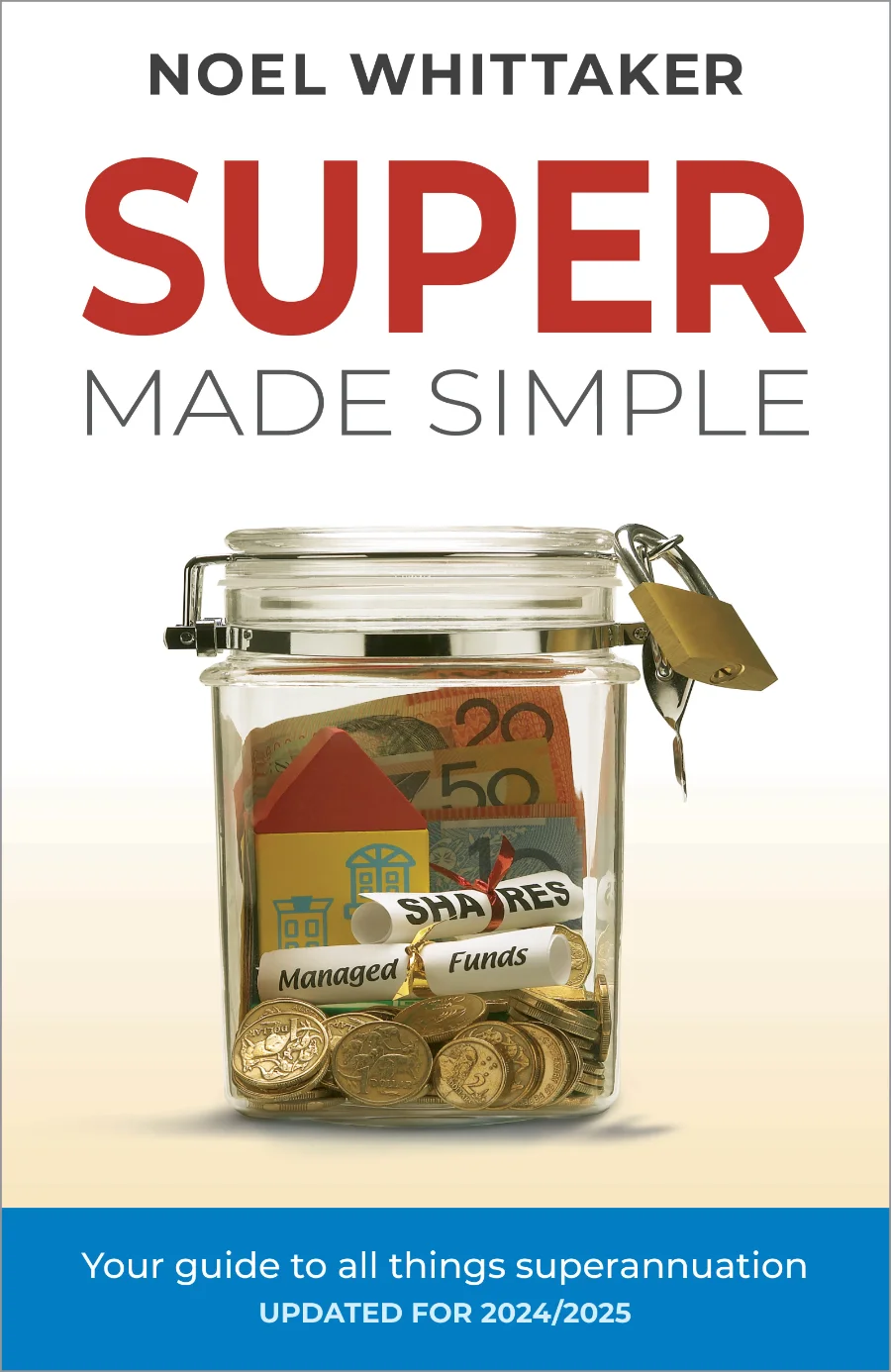
Pension changes
The quarterly age pension adjustments have been announced, and thanks to inflation, all pensioners will receive an income boost. The pension system can be confusing because there are three changes each year: in July the asset and income thresholds are adjusted, while in September and March the pension payment amounts are updated.
 Image by Drazen Zigic on Freepik
Image by Drazen Zigic on Freepik
You can download the latest pension charts and use the updated age pension calculator and deeming calculator on my website: Latest pension charts available on my Free Downloads page Go to updated age pension calculator Go to deeming calculator The single pension has increased by $4.60 a fortnight and the couples pension by $3.50 per fortnight each. When the pension rate increases, the upper threshold for eligibility rises as well. The new cut-off point for a homeowner couple is $1,047,500 and for a single homeowner it’s now $697,000. Most wealthier pensioners are asset-tested, yet I keep receiving emails from them asking if they’re allowed to earn extra income. The answer is yes; if you’re asset-tested, the income test does not apply. A single pensioner with $560,000 in assets, who will now receive $411 a fortnight could earn up to $43,000 a year, including deemed and employment income, without affecting their pension, because they remain asset-tested. Your home is not assessable, but your furniture, fittings and vehicles are. Many pensioners mistakenly value these at replacement cost, which can be costly. Every $10,000 in excess assets reduces the pension by $780 per year, so it’s important to value these items at garage sale prices, not replacement cost.
 Image by Freepik
Image by Freepik
There is no penalty for spending money on holidays, living expenses or home renovations. However, doing so purely to increase your pension is not a smart financial strategy. For example, if you spend $100,000 on renovations, your pension may increase by just $7,800 per year, meaning it would take nearly 13 years to recover the cost. That said, the benefits of improving your home or travelling should also be considered. The key is to spend wisely, rather than simply trying to boost your age pension. Each year on 20 March and 20 September, Centrelink revalues market-linked investments, such as shares and managed funds, based on the latest unit prices. These investments are also revalued when you report a portfolio change or request a revaluation. If the value of your investments falls, your pension may increase, whereas if the value rises, your pension may decrease. The rules are in favour of pensioners. If your portfolio increases due to market movements, you don’t need to notify Centrelink – it will be adjusted at the next six-monthly revaluation. However, if your portfolio falls, you can notify Centrelink immediately, which may result in an increase in your pension sooner. The devil is in the detail. If one member of a couple has not yet reached pension age, it can be prudent – where appropriate – to keep as much superannuation as possible in the younger person’s name. Superannuation in accumulation mode is exempt from Centrelink’s asset test until the account holder reaches pension age. However, the moment it moves into pension mode, it becomes assessable, regardless of age. A common trap arises when a loan is used to buy an investment property, but the mortgage is secured against the pensioner’s own home. Centrelink does not deduct the debt from the investment property’s value unless the mortgage is held against that property. If the mortgage is secured against another asset, such as the family home, the full gross value of the investment is assessed for the assets test, while the loan is not deducted. This can have a severe impact on pension entitlements. Centrelink also limits gifting to $30,000 over a rolling five-year period, in conjunction with the $10,000 per year allowable limit. Any excess is treated as a deprived asset for five years. Time and again, we hear of pensioners in failing health giving away assets to family, hoping to experience the joy of generosity while still alive, only to later realise this act has cost them much of their pension. Unfortunately, space constraints mean we can only scratch the surface today, but these examples highlight the importance of seeking expert advice before making major financial decisions. As the saying goes, “Birth is easier than resurrection” – it’s far less costly to get it right from the start than to try and fix mistakes later.
The Trump administration
Donald Trump is a controversial figure but so much goes on behind the scenes that the media never tell us. Below there is a link to an extraordinary video interview with Howard Lutnick, best known as the CEO who rebuilt Cantor Fitzgerald after 9/11, who is now the 41st United States Secretary of Commerce in the Trump administration. 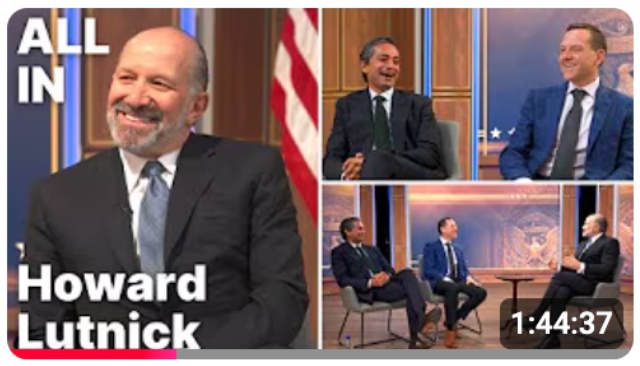 Stepping down from his corporate roles, Lutnick has become a key economic voice in government. He’s already making waves with proposals to eliminate federal income tax, suggesting tariffs could fund government operations instead. He’s also pushing for nationwide rural broadband using Elon Musk’s Starlink system. After the interview was highly recommended by some of our friends, Geraldine and I sat down to watch it the other night. And it was riveting. Lutnick talks about being responsible for the entire transition for the Trump government and goes into detail about how the cabinet ministers were picked, and how he plans to increase revenue by $1 trillion at the same time as reducing expenses by $1 trillion. We loved the bits about dealing with Elon Musk and how he got a shock when he met him about four months ago to find he lives in an old house with very cheap furniture. This video has made me much more confident about America’s financial future.
Stepping down from his corporate roles, Lutnick has become a key economic voice in government. He’s already making waves with proposals to eliminate federal income tax, suggesting tariffs could fund government operations instead. He’s also pushing for nationwide rural broadband using Elon Musk’s Starlink system. After the interview was highly recommended by some of our friends, Geraldine and I sat down to watch it the other night. And it was riveting. Lutnick talks about being responsible for the entire transition for the Trump government and goes into detail about how the cabinet ministers were picked, and how he plans to increase revenue by $1 trillion at the same time as reducing expenses by $1 trillion. We loved the bits about dealing with Elon Musk and how he got a shock when he met him about four months ago to find he lives in an old house with very cheap furniture. This video has made me much more confident about America’s financial future.
Property sales – tax clearance needed
The following email came from a frustrated and unhappy reader who didn’t mince words:
“Why does the current government require Capital Gains Tax Clearance Certificates from every property seller in Australia? I understand the need to identify foreign property owners for CGT, but why apply it to everyday Australians who own and live in just one property? Surely, there must be a better way to identify foreign investors.
I am 68 and live on acreage. I don’t want to downsize because my one-acre block brings me joy through flower and vegetable gardening in my retirement. My issue is that many people might miss this requirement and risk losing a significant percentage of their home’s sale price. What can be done to prevent this?”
 Image by gpointstudio on Freepik
Image by gpointstudio on Freepik
It was news to me, but given how important this could be, I’ve done the research. Mark Molesworth, tax partner at BDO, tells me the tax law on withholding tax for Australian real estate sales changed from 1 January 2025. From that date, all sellers must obtain a residency clearance certificate – if they are an Australian resident – or risk having the buyer withhold 15% of the market value of the property. These rules have been gradually extended by governments of all sides since they were first introduced in 2016. For contracts signed before 1 January 2025, the new legislation doesn’t apply, even if settlement happens in 2025. For those pre-existing contracts a clearance certificate is only required if the market value of the property exceeds $750,000. But for all contracts signed on or after that date, a clearance certificate will be mandatory regardless of the property value. A clearance certificate is a simple one-page document issued by the ATO confirming that the seller is an Australian resident. Without it, part of the sale proceeds will be withheld for tax purposes. If a seller doesn’t provide a valid clearance certificate to the purchaser at or before settlement, the purchaser is legally required to withhold 15% of the purchase price and pay it to the ATO. This can have a big impact on the seller’s finances and cash flow since they’ll need to wait until their next tax return is processed to receive any refund that may be due. Sellers can apply for a clearance certificate online through the ATO website. The process is free, and most certificates are issued within a few days. However, in some cases, it can take up to 28 days. A solicitor or conveyancer can handle this on your behalf, but it’s also fairly easy to do yourself. It’s important to apply for a clearance certificate as soon as you decide to sell your property. The certificate is valid for 12 months from the date of issue, and if multiple sellers are listed on the property title, each one must obtain their own certificate. Also, make sure the title of the property before sale matches your current name and is correctly identified with the ATO. This is particularly important if the seller is a deceased estate, the sale is part of a property settlement, or a vendor’s name differs from what appears on the contract. For example, it could be a name change due to marriage or divorce. Even a small discrepancy at settlement can cause delays, leading to unnecessary complications and risks. Taking the time to ensure all details are correct in advance can save a great deal of stress and potential financial impact. For purchasers, it’s essential to receive a valid clearance certificate from the seller at or before settlement. If you don’t, you’re legally required to withhold 15% of the purchase price and remit it to the ATO.
Age care and reverse mortgages
Age care is so confusing, and we find that many people are considering reverse mortgages when they may not need to. This is a question and answer which will be published in the national press in about two weeks:
 Image by Freepik
Image by Freepik
Question
We’re trying to secure a place for Mum in a dementia-supported aged care facility, with entry costs of around $500,000 plus daily fees. Most places are increasing this to at least $650,000 from July 1. Dad can access up to $350,000 through a reverse mortgage on their $1 million home. He has about $160,000 in super, which should cover the interest for roughly five years. He’s still living independently, so selling the home isn’t practical – downsizing would likely mean moving further out, paying body corp fees and losing access to family, medical care and support. Do you know any reputable lenders that might allow access to more than $350,000 against the home to help cover the deposit and make their savings last?
Answer
Reverse mortgage specialist Paul Dwyer tells me that from the information provided, they have around $160,000 in savings and $24,000 in other assets. If Mum enters care and Dad remains at home, the house is excluded from the assets test. In this position, Mum would be assessed as partially supported by the Government. She wouldn’t pay a means-tested care fee but would pay the standard daily care fee of $63.82. There may be a small additional services fee, and she’d contribute about $14.84 per day for accommodation. As a partially supported resident, she can’t be asked to pay a RAD or DAP. The main challenge is finding a facility with a concessional room, but based on the details you’ve given, no lump sum is required.
Do NOT scan any mystery gift
There is apparently a new scam out there and it’s exceptionally dangerous. Here’s how it works. Victims receive a mystery package from an unknown party complete with your name, information and official-looking packaging from one of the biggies – think Amazon, Walmart etc – and in it there’s a card saying you’ve received a gift.  But you don’t know who sent it. So, naturally, the very same note invites you to scan the QR code included at which point everything on your device is compromised… names, contacts, credit cards, accounts, links etc. A variation of this is being used in England where criminals are putting fake QR codes over the top of legitimate QR codes at car parks. So, it’s a bonus – you get your money stolen and a fine from the authorities! Yeesh 🤦 If only criminals would put half of that creativity and energy into something useful!!
But you don’t know who sent it. So, naturally, the very same note invites you to scan the QR code included at which point everything on your device is compromised… names, contacts, credit cards, accounts, links etc. A variation of this is being used in England where criminals are putting fake QR codes over the top of legitimate QR codes at car parks. So, it’s a bonus – you get your money stolen and a fine from the authorities! Yeesh 🤦 If only criminals would put half of that creativity and energy into something useful!!
And finally
At the art of giving, he stops at nothing.
Women sometimes make fools of men, but most guys are the do-it-yourself type.
Hospitality: making your guests feel like they’re at home, even if you wish they were.
Get your facts first, then you can distort them as you please.

I would like to take you seriously, but to do so would be an affront to your intelligence.
They said I could become anything. So I became a disappointment.
A modest man, who has much to be modest about.
The last time I was someone’s type, I was donating blood.
Marriage is a great institution, but I’m not ready for an institution. ~Mae West
He taught me housekeeping; when I divorce I keep the house. ~Zsa Zsa Gabor
Behind every successful man is his woman. Behind the fall of a successful man is usually another woman.
Women will never be equal to men until they can walk down the street with a bald head and a beer gut… and still think they are sexy!
 I hope you have enjoyed the latest edition of Noel News.
I hope you have enjoyed the latest edition of Noel News.
Thanks for all your kind comments. Please continue to send feedback through; it’s always appreciated and helps us to improve the newsletter.
And don’t forget you’ll get more regular communications from me if you follow me on X – @NoelWhittaker.
Noel Whittaker



